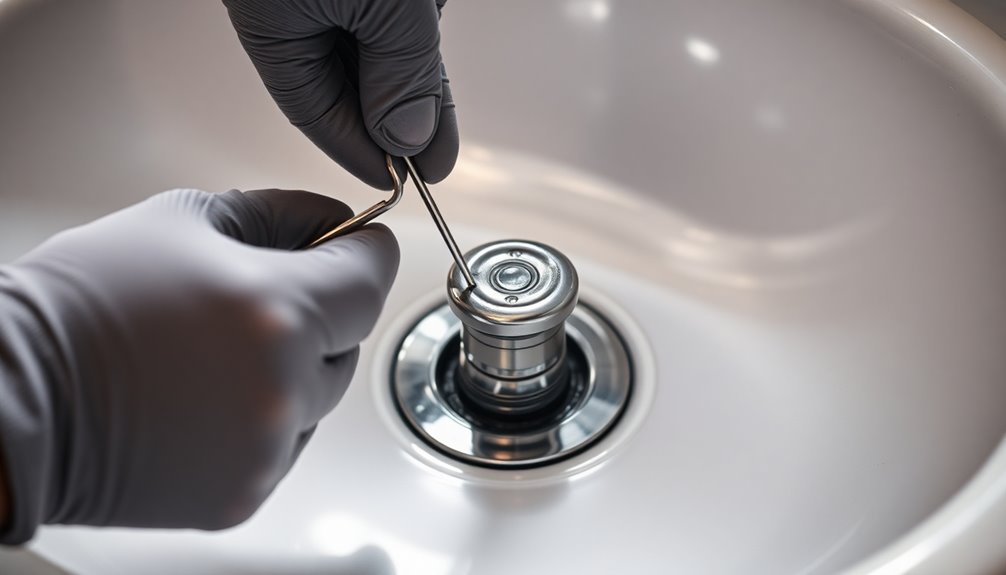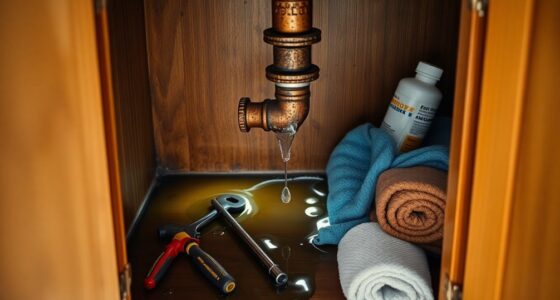If your sink stopper's stuck, you can try a few quick fixes. Manually pull it up if there's a grip on top. Alternatively, use a suction cup or plunger to create upward force. If it's a metal stopper, a rare earth magnet can help. For a more thorough approach, disconnect the pivot rod, clean the stopper, and check for debris. Regular maintenance can prevent these issues from happening. Stick around for more expert tips on keeping your sink in top shape!
Key Takeaways
- Manually pull up the sink stopper or use a suction cup for better grip if it's stuck.
- Check for debris obstructing the stopper and clean it with warm, soapy water.
- Disconnect the pivot rod from the clevis strap to facilitate removal and cleaning.
- Regularly lubricate moving parts with silicone-based lubricant to maintain functionality.
- Inspect and tighten loose pivot nuts to ensure proper connection and operation of the stopper.
Quick Fixes to Unstick a Sink Stopper
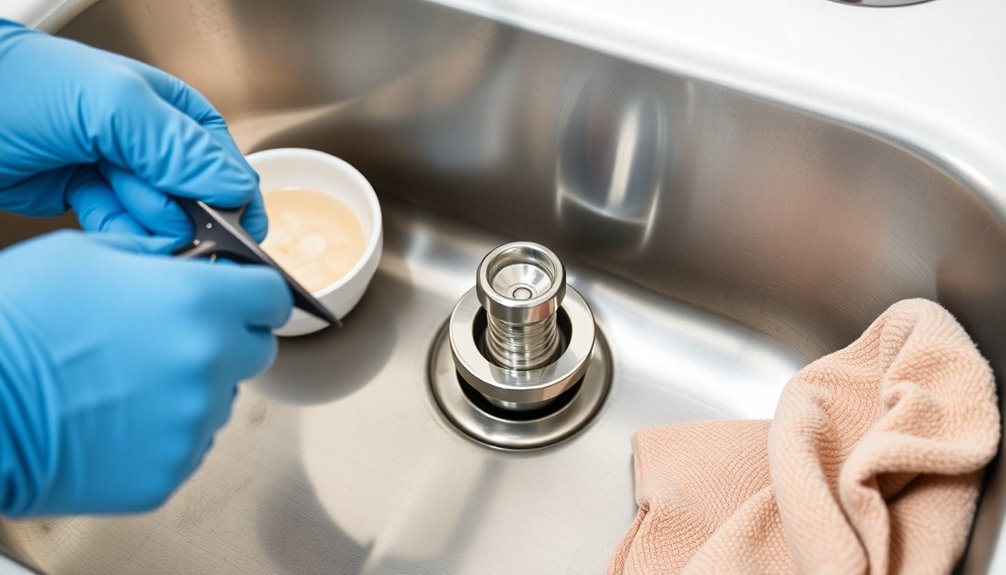
If you find yourself dealing with a stuck sink stopper, there are several quick fixes you can try to get it moving again.
First, manually pull up the sink stopper if there's a grip on top, applying steady upward force.
If that doesn't work, grab a suction cup; make certain the drain's covered with water, press down, and pull upward swiftly to create a vacuum seal.
You can also fill the basin with water and use a plunger to generate upward force.
For metal components, a rare earth magnet can help lift the stopper.
Finally, wear a rubber glove to gain traction, then push and twist the pop-up drain to manipulate its position and unstick a sink effectively.
Removing & Cleaning a Stuck Sink Stopper
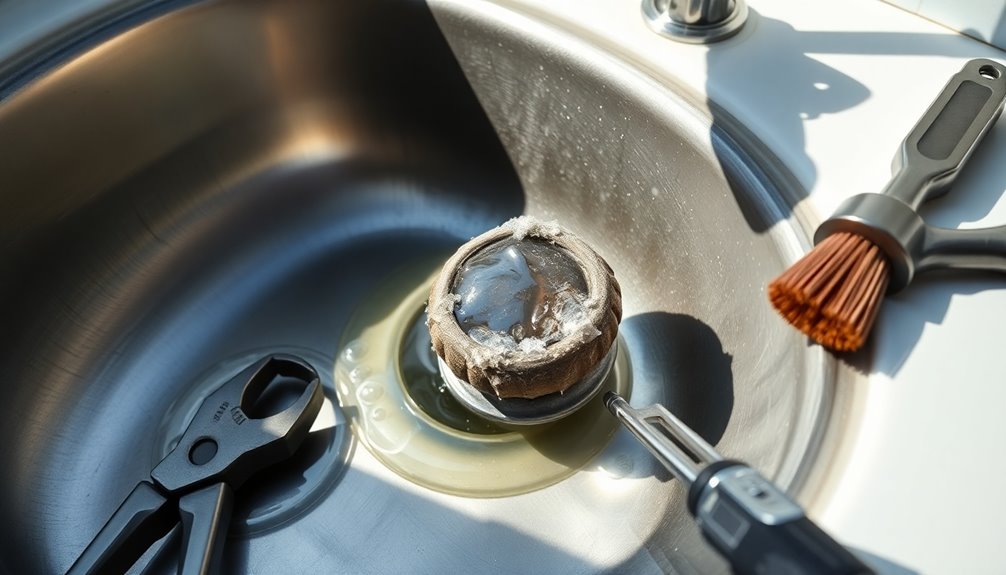
After trying some quick fixes to unstick your sink stopper, you might still need to remove and clean it for a more permanent solution.
Start by familiarizing yourself with the drain assembly, including the drain stopper, lift rod, and pivot rod. Clear the area under the sink for better visibility and access.
Next, disconnect the pivot rod from the clevis strap by squeezing the spring clip and sliding it off, allowing you to remove the stuck stopper.
Clean the stopper thoroughly with warm water and dish soap, soaking it in soapy water if needed.
Finally, check for buildup in the pipes and use a natural drain cleaner, like baking soda and vinegar, to dissolve any debris and prevent future clogs.
Troubleshooting Stuck Sink Stoppers
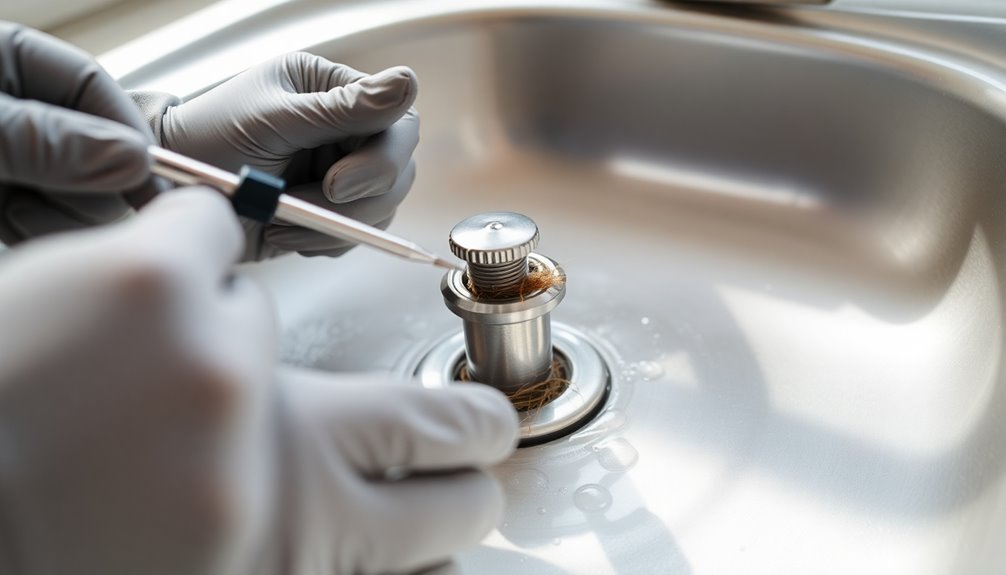
Have you ever wondered why your sink stopper won't budge? To troubleshoot a stuck sink stopper, start by identifying its type—popup or traditional lift rod. Check for visible debris obstructing movement and examine the mechanical components, like the lift rod and pivot assembly, for wear or breaks. Below is a quick reference:
| Issue | Solution |
|---|---|
| Buildup in drain pipe | Clean the stopper regularly |
| Misaligned pivot rod | Reinsert into clevis strap |
| Lubrication needed | Apply lubricants like WD-40 |
| Loose pivot nuts | Tighten to secure connections |
| Worn mechanical parts | Replace as necessary |
Regular maintenance, including cleaning the stopper and drain, can prevent issues and keep your sink functioning smoothly.
Prevention Techniques

To keep your sink stopper working smoothly, establish a regular cleaning schedule to eliminate buildup.
You should also lubricate the components periodically and keep an eye on any signs of wear or damage.
Taking these simple steps can save you from future frustrations with a stuck stopper.
Regular Cleaning Schedule
Establishing a regular cleaning schedule for your sink and stopper can make a significant difference in preventing issues like sticking.
Here's how to keep your bathroom sink stopper in top shape:
- Weekly: Wipe down the sink and stopper with a damp cloth and mild dish soap to remove soap scum and surface grime.
- Monthly: Use a mixture of baking soda and vinegar to naturally clean the drain and stopper assembly, helping to dissolve minor clogs.
- Inspect: Check the mechanism of your sink stopper every few months for signs of wear or damage, ensuring everything functions properly.
- Lubricate: Consider applying a silicone-based lubricant to the moving parts every few months for smooth operation and to prevent sticking.
Lubrication of Components
Regular cleaning helps keep your sink stopper functioning well, but lubrication plays an essential role in prevention too.
To guarantee your stopper mechanism operates smoothly, apply a silicone-based lubricant to the moving parts every few months. Focus on the pivot rod and pivot nut, as these areas often accumulate buildup and can cause jamming.
If you encounter stuck components, you can use WD-40 as a penetrating oil, but remember to follow up with a long-lasting lubricant for peak function. A light application on the lift rod and clevis strap connection points will further reduce friction and prevent wear.
With consistent maintenance, you can extend the lifespan of your sink stopper mechanism and avoid future sticking problems.
Monitor for Wear
Monitoring for wear in your sink stopper assembly is essential for maintaining its functionality. Regular checks can prevent future issues. Follow these steps:
- Inspect the pivot rod and nut for cracks or corrosion, as wear here can lead to malfunction.
- Verify rubber seals on the stopper and drain are in good condition; worn seals can cause sticking.
- Periodically clean the stopper mechanism to remove hair, soap scum, and debris that contribute to wear.
- Check the tightness of the pivot nut; a loose nut can affect the stopper's movement.
Additionally, consider lubricating the moving parts every few months to reduce friction and wear.
Keeping an eye on these components will help guarantee your sink functions smoothly.
Expert Q&A
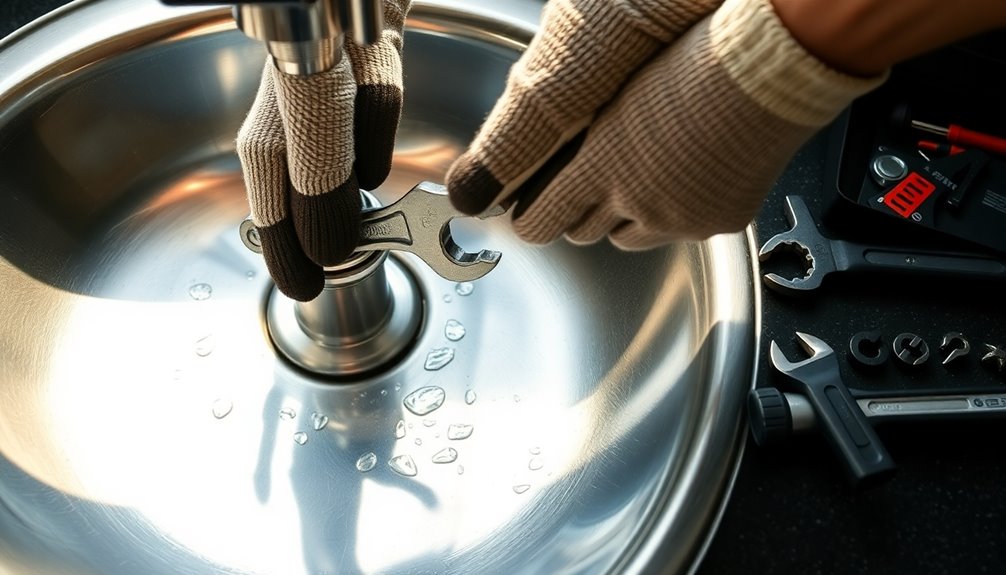
When you're faced with a stuck sink stopper, it can be frustrating, but understanding a few expert tips can help you tackle the problem efficiently.
First, check for debris buildup around the stopper mechanism. Cleaning it with warm, soapy water can often dislodge blockages.
Next, inspect the lift rod and horizontal rod connections, ensuring they're properly aligned and securely fastened.
If the stopper remains stuck, consider using lubricants like WD-40 on the pivot mechanism to provide the slickness needed.
Finally, if all else fails, removing the drain assembly may be necessary to manually free the stopper.
Regular maintenance, including cleaning and lubricating components, can prevent future stuck issues and enhance your plumbing experience.
Tips
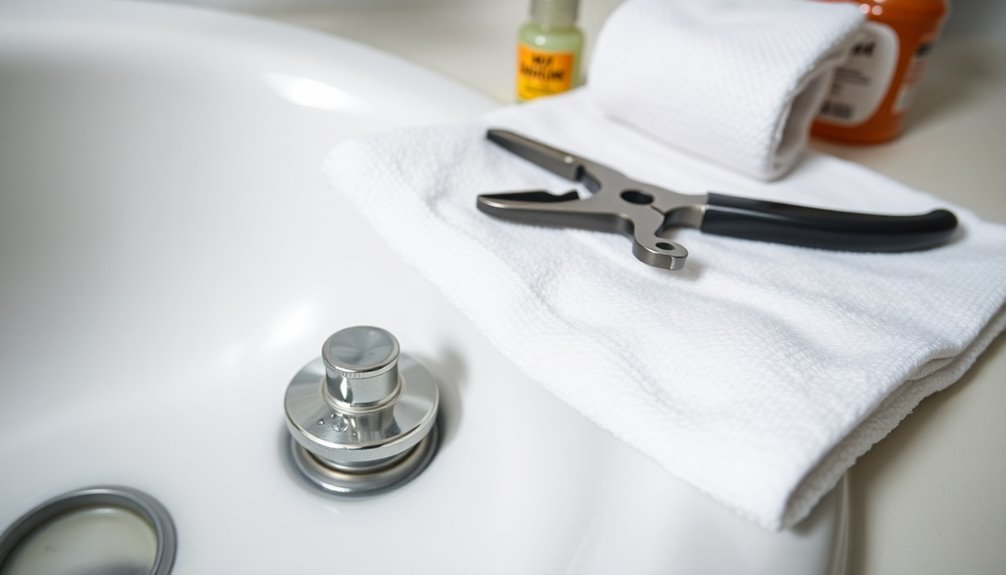
When dealing with a stuck sink stopper, you can try several effective approaches.
Manual pull techniques, proper lubrication, and alternative removal methods can make all the difference.
Let's explore these tips to help you get your sink back in working order.
Manual Pull Techniques
To successfully lift a stuck sink stopper, start by firmly gripping any accessible edges or the lift rod, if it's visible.
If it doesn't budge, try these manual pull techniques:
- Use your fingers: Pull upward while maintaining a strong grip on the stopper's edges.
- Employ a tool: Gently push a metal nail file or flathead screwdriver around the edges to loosen debris.
- Suction cup magic: Press a suction cup against the stopper, cover the drain with water, and pull upward quickly to create suction.
- Rubber glove leverage: Wear a rubber glove for a better grip, allowing you to pull more forcefully without slipping.
These methods should help you dislodge that stubborn stopper!
Lubrication and Maintenance
After trying manual pull techniques to lift a stuck sink stopper, it's important to maintain the mechanism to prevent future issues. Regular lubrication of the moving parts will minimize friction and keep your sink stopper functioning smoothly. Here are some tips:
| Task | Frequency | Note |
|---|---|---|
| Lubricate moving parts | Every 3 months | Use silicone or WD-40 |
| Routine cleaning | Monthly | Clear hair and soap scum |
| Inspect pivot rod | Every 6 months | Look for bends or breaks |
Don't forget to lubricate the spring mechanism on pop-up stoppers too. After cleaning, make sure the pivot nut is secure but not overly tightened to avoid future sticking. Regular maintenance will keep your sink in top shape!
Alternative Removal Methods
If you find your sink stopper stuck and conventional methods haven't worked, several alternative removal techniques can help.
Here are some effective strategies:
- Suction Cup: Press a suction cup against the stopper, adding water to the basin for better suction, then pull upwards.
- Plunger: Fill the sink with water, ensuring a tight seal with the plunger, and make firm, quick upward pulls to create suction.
- Rare Earth Magnet: If your stopper is magnetic, place a rare earth magnet near it to lift it out easily.
- Metal Nail File: Use a metal nail file or flathead screwdriver to shimmy the edges of the stopper, loosening any debris.
If accessible, consider removing the drain assembly to detach the pivot rod or apply lubricant to stuck components.
Frequently Asked Questions
How Do You Get a Stuck Sink Stopper Out?
When you're dealing with a stuck sink stopper, first verify the sink's drained.
Try pulling it up manually; using rubber gloves can give you a better grip.
If that doesn't work, grab a suction cup to create a seal and pull upward.
For stubborn cases, fill the sink with water and use a plunger to create suction.
If it's still stuck, check underneath the sink and disconnect the mechanism to remove it.
How to Lubricate a Pop-Up Sink Plug?
To lubricate a pop-up sink plug, start by cleaning and drying the area.
Then, apply a penetrating oil like WD-40 around the edges of the stopper, letting it sit for 5-10 minutes.
After that, gently press and release the stopper several times to work the lubricant in.
For long-lasting results, consider using a silicone-based lubricant.
Regularly inspect and clean the stopper mechanism to prevent future sticking.
Why Won't My Drain Stopper Come Out?
If your drain stopper won't come out, it could be due to several issues.
You might've buildup around the mechanism, making it hard to lift. Check if the lift rod is misaligned or damaged, as that can block movement.
Also, guarantee there's a good grip on the stopper; if not, you may need to try suction.
Finally, inspect for any loose connections or tight nuts that could be causing the problem.
How to Fix a Pull up Sink Stopper?
Fixing a pull-up sink stopper can feel like tackling a mountain, but it's simpler than you think.
Start by clearing the area under your sink to access the lift rod and horizontal rod. Check for loose parts and verify everything's securely attached.
If it's still stuck, use a short screwdriver to push the drain plunger up from below. A little penetrating oil can work wonders too.
If all else fails, consider replacement parts.
Conclusion
You've tackled the issue of a stuck sink stopper, and just when you thought it was a minor annoyance, you discovered it's a common problem many face. By using the quick fixes and cleaning techniques outlined, you not only solved your own dilemma but also gained valuable skills to share with friends. Next time someone mentions their sink troubles, you'll be ready to lend a hand—and who knows, maybe a little DIY magic will inspire them too!
